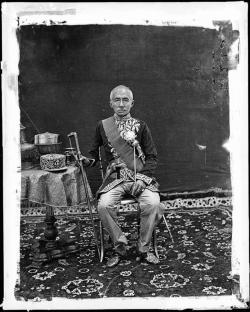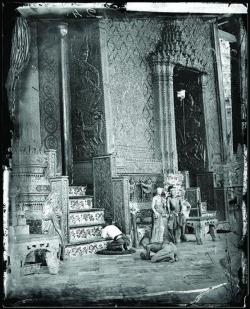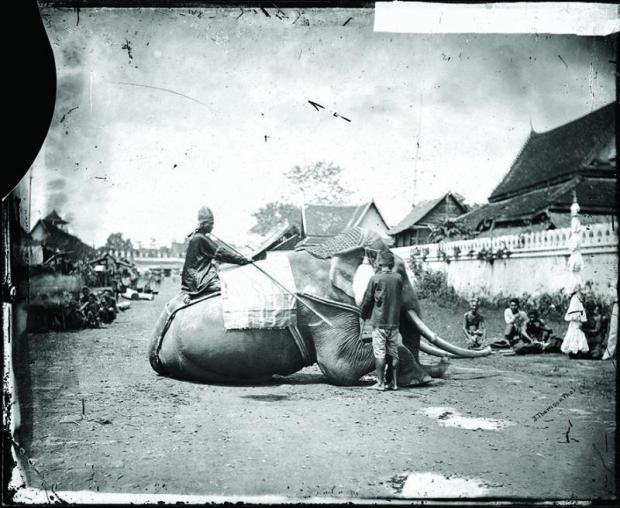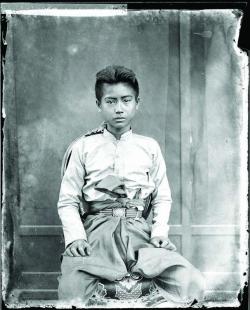In the mid-19th century, John Thomson arrived in Siam with a fairly new invention of those days: photography. The Scot would set up his camera in exquisite parts of Bangkok and take pictures — in those days having one's picture taken was an elaborate and even privileged activity — of some of the most important figures and places, including King Rama IV and V.

The Chao Phraya River as seen from the main spire of Wat Arun.
From Saturday, the public is invited to feast their eyes on photographs taken from 1865-1866 by Thomson, one of the most significant photography pioneers in Siam, at the National Gallery Bangkok.
A total of 60 photographs taken by Thomson, who arrived here in 1865 as part of his Far East voyage, will be showcased at the "Siam Through The Lens Of John Thomson" exhibition from Jan 10-Feb 28. Marking 150th year since his arrival, the exhibition features a collection of photographs that portray a glimpse of Siam in days of yore. This is the largest collection of Thomson's photographs ever mounted in Thailand.
Some of the photographs are also regarded as the best photographs ever shot in Siam in the 19th century. All of them — in black and white — are to be appreciated at a striking size of at least a metre long.
Highlights include portraits of King Mongkut (King Rama IV) and King Chulalongkorn (King Rama V), who was crown prince in his teen years. These are historically the first-ever pictures of these Siamese kings. The exhibition also features photographs of the majestic grandeur of Royal Barge Anantanakkharat and a royal parade, photographs of neighbourhoods and river-scapes around Bangkok, as well as photographs of Angkor Wat and coastal China, where Thomson travelled after leaving Bangkok
"The exhibition takes place at the National Gallery, which is located at the area where many of the photographs were shot," said MR Narisa Chakrabongse, lead organiser and curator of the exhibition.
"Thomson was a fearless man," said Paisarn Piemmettawat, assistant to the exhibition's organiser and a Thomson fan. "He came to the Far East when he was 25. He was afraid of nothing."

King Mongkut in Bangkok.
Before photography became banal and ubiquitous, its historical value was immense. It's suffice to say that much of what Thomson captured through this camera had never been photographed before — the sprawl of the Grand Palace compound, ancient ceremonies, the tonsured prince, even the faces of the people staring at the camera in awe, all of this seems to have acquired a metaphysical power of something that's gone but remains steadfastly here.
Thomson was born in 1837 in Edinburgh. He learnt the basics of photography during his apprenticeship with an optical and scientific instrument maker. In 1862, at 25, he boarded a steamer to Singapore to join his brother who had travelled there before him.
Together, the brothers undertook a business making marine chronometers and optical and nautical instruments. Thomson also opened a photographic studio, which became popular with European merchants. He then moved around the region, from Malaya (Malaysian Peninsula) and to the island of Sumatra to Ceylon (Sri Lanka) and India to photograph the areas ravaged by The Great Calcutta Cyclone of 1864.
In 1865, Thomson sold his studio in Singapore and came to Siam after being imbued by first-hand accounts of Siam, Cambodia and Laos by French naturalist and explorer Henri Mouhot, who came to Indochina in 1858.
Arriving in Bangkok on Sept 28, 1865, he soon showed his ambition to take photographs of King Mongkut at the British embassy. At the time when photography was only practised by a few, his resolve intrigued the king.
Thomson was the first photographer to be allowed into the Grand Place to take portraits of the king and the other royal members. He earned much adoration from King Mongkut for his photographic flair.

The hallway in front of Wat Phra Kaeo's central ubosot.
"His photographic style can be perceived from the beauty of his work," said Paisarn. "Back then when all he had was natural light, he still managed to get the beautiful photographs."
During one royal procession moving past Wat Pho, the king called for a pause to the moving parade and asked everybody to stay still for photos taken by Thomson.
"The king was sitting on a litter and everyone was sitting down on the ground," said Paisarn. "It was a historical moment that showed great Thai tradition. The king was fully decorated. Imagine how beautiful the photograph of this event is."
Apart from being privileged to photograph all things royal, Thomson also secured an impressive number of views of the capital. He also travelled extensively in Ayutthaya and Petchaburi before setting out for Cambodia.
Upon his arrival in Phnom Penh, with a special pass from the king, the team was lavishly greeted by King Norodom of Cambodia. The team also procured a complete set of animals to transport them across the jungle to Angkor Wat. The jungle trek proved almost deadly as Thomson contracted jungle fever.Thomson spent two weeks documenting the wonder — his photographs are the earliest photographs of Angkor Wat. He also photographed the Cambodian king and visited Saigon before returning to Siam. King Mongkut was awestruck at the massive size of Angkor Wat after seeing the place in a photograph for the first time.
After his retirement from running his studio in 1910, Thomson returned to Edinburgh and spent the rest of his time with his wife. In 1921, a collection of more than 600 photographic plates were acquired by Sir Henry Wellcome, an American-British pharmaceutical entrepreneur and collector, who later established a museum to keep his collectibles.
The negatives were stored at the Wellcome Library until the museum recently carried out a conservation project to digitise all of Thomson's negatives.
The digitisation of the old negatives allowed the photographs to be printed in an impressive size. Since then, the photographs have been shown at major international exhibitions around the world.
Narisa knew about Thomson's photographs of Siam when her Chinese friend Betty Yao, who organised the "China Through The Lens Of John Thomson" exhibition in 2009, introduced her to them.
Impressed by the significance and beauty of the photographs, she was inspired to organise an exhibition that features Thomson's collection of photographs taken in Siam, the planning of which started in 2009.
"It's surely fascinating for Thai people to see what the country looked like 150 years ago," Narisa said. "I think people will be really impressed."
"Siam Through The Lens of John Thomson" runs from Jan 10-Feb 28 at the National Gallery, Chao Fah Road. Admission is free.

A white elephant belonging to King Mongkut.

A Siamese youth.

